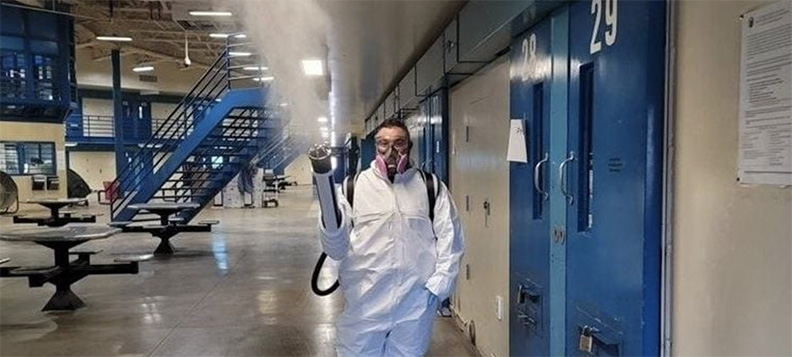by Linsdey Van Ness
Nearly every day, Jan Salvay checks for her nephew’s name on the Nevada Department of Correction’s website: Nicholas, 39, jailed in a credit card forgery case. Then she checks the state’s list of deaths in custody—just to make sure his name isn’t there.
“He’s … scared he’s going to get sick, and he’s going to die,” Salvay said.
When she last visited him, in February at a work camp, he was expected to be released in time to vote in the general election. Not long after that visit, he was transferred to a regular state prison because of an illness; then the pandemic hit and work camps closed.
“Then the [release] delays started. They explained, ‘We had to stop the work programs. So now you’re not getting those days off from your sentence,’” Salvay said, summarizing one of many calls she’s made to the corrections department. “I felt like that doesn’t seem right.”
By mid-December, the online portal had a release date of Jan. 14. By the start of the new year, it changed to Jan. 20. Last week, five more days were added. “Not surprised, but definitely disgusted,” Salvay said in a text. She called the state’s family services line to explain that Nicholas had already signed discharge papers. The woman who answered put Salvay on hold, then said they changed the date back to Jan. 20. “Huge relief; I cried when she said it,” Salvay texted this time.
In Nevada, 40 people have died of COVID-19 in prisons, and more than 2,900 have tested positive for the disease.
The COVID-19 infection rate in prisons is four times higher than that in the general U.S. population. Yet even as family members, incarcerated people and advocates urge states to release who they can in order to reduce deaths, some states have gone in the opposite direction—keeping incarcerated people from taking advantage of early release programs.
In at least half the states, incarcerated people can have time taken off their sentence by working, getting educational degrees or completing programs such as drug and alcohol rehabilitation, according to research by the National Conference of State Legislatures. Sometimes programs or work are required as part of a sentence.
Several states have distributed time credits in other ways to make up for lost programs. California and New Jersey have even increased time credits because of the coronavirus.
As the pandemic stretches on, though, with some states hesitant to administer vaccines to incarcerated people before other groups, advocates say states could make better use of systems allowing “good time” credits to reduce prison populations.
“We are calling on states to, rather than letting good time fall to the wayside, take good time and leverage it,” said Wanda Bertram, a spokesperson for Prison Policy Initiative, a criminal justice think tank based in Northampton, Massachusetts. “First because it’s fair, and second because it will let more people get out of prison now.”
But the policies aren’t popular with some law enforcement officials and lawmakers, who argue incarcerated people should serve the sentence they’ve been dealt, COVID-19 risks or not.
Steps Forward, Steps Back
Daniel Smith doesn’t want to turn himself in to county jail.
He doesn’t fear the 60-day sentence at Pottawattamie County Jail in Iowa for a parole violation, he said. He’d handle that. What he fears is the coronavirus.
“Do I turn myself in and deal with the increased chances of getting COVID,” Smith, 37, asked in a recent phone interview, “or do I not turn myself in and take the chance of getting myself in trouble?”
The coronavirus has sickened nearly 300,000 people in state prisons, and more than 1,900 who tested positive have died, according to The Marshall Project and The Associated Press, which jointly collect data on state corrections facilities. Data on cases in county facilities is sporadic.
On March 16 of last year, when the Trump administration announced a plan called “15 Days to Slow the Spread,” state officials made efforts to minimize congregate settings, including in jails, according to Anna Harvey, director of New York University’s Public Safety Lab and a co-author of multiple jail population studies for the National Commission on COVID-19 and Criminal Justice.
Through the end of April, jail populations dropped by 30% from a combination of releasing incarcerated people early and fewer new admissions. “It seems like the jail populations responded to this clear national set of policy guidelines,” Harvey said.
But as state officials loosened coronavirus-related restrictions during the summer, jail populations began to creep up again. By September, jails regained half of the people lost, she said.
A similar trend was documented in state and federal prisons, according to the Prison Policy Initiative.
All along, some law enforcement officials and lawmakers have resisted moves to reduce incarcerated populations.
n April, after a state order set a new zero-bail policy for most misdemeanor and low-level felonies, Fresno County, California, Sheriff Margaret Mims said in a video on the office’s Facebook page, “This is gonna set us back. This is gonna mean more crimes.” (The zero-bail policy ended in June.)
In December, Todd Spitzer, the Republican district attorney in Orange County, California, criticized a court ruling to cut the county jail population in half. In a statement, he said the ruling “will release dangerous and violent criminals back into our neighborhoods to commit more crimes and victimize more people.”
“Nothing, not even a pandemic suspends the rule of law,” he said.
Letting people go
In Nevada, Jodi Hocking started a Facebook group in August for people concerned about incarcerated loved ones during the pandemic. She called it “Return Strong.” It has grown to more than 370 members and works with the ACLU of Nevada. Hocking and other members have called for better conditions in prisons and compassionate release, a process of releasing ill people from prison early.
As of November, the state Department of Corrections said only two of nearly 14,000 incarcerated people qualified for compassionate release on the basis of susceptibility to COVID-19 and other factors, according to The Nevada Independent, which reported it was not clear whether those two had actually been released.
Return Strong has received letters from 320 people in Nevada’s prisons. Like Salvay’s nephew, many say they are not receiving credits they expected and are having release dates pushed back.
“Many people are sitting there,” Hocking said, “and every month they are losing time.”
The Nevada Department of Corrections did not provide information by publication time on how the inactive programs are affecting sentence lengths. The office of Democratic Gov. Steve Sisolak did not respond to requests for comment.
In Nevada, Jodi Hocking started a Facebook group in August for people concerned about incarcerated loved ones during the pandemic. She called it “Return Strong.” It has grown to more than 370 members and works with the ACLU of Nevada. Hocking and other members have called for better conditions in prisons and compassionate release, a process of releasing ill people from prison early.
As of November, the state Department of Corrections said only two of nearly 14,000 incarcerated people qualified for compassionate release on the basis of susceptibility to COVID-19 and other factors, according to The Nevada Independent, which reported it was not clear whether those two had actually been released.
Return Strong has received letters from 320 people in Nevada’s prisons. Like Salvay’s nephew, many say they are not receiving credits they expected and are having release dates pushed back.
“Many people are sitting there,” Hocking said, “and every month they are losing time.”
The Nevada Department of Corrections did not provide information by publication time on how the inactive programs are affecting sentence lengths. The office of Democratic Gov. Steve Sisolak did not respond to requests for comment.
This story was originally published by Stateline, an initiative of The Pew Charitable Trusts
Author Lindsey Van Ness is an Editorial Assistant for Stateline
The top photo shows correctional official using decontamination fogger in Northern Nevada Correctional Center, courtesy of the Nevada Department of Corrections


